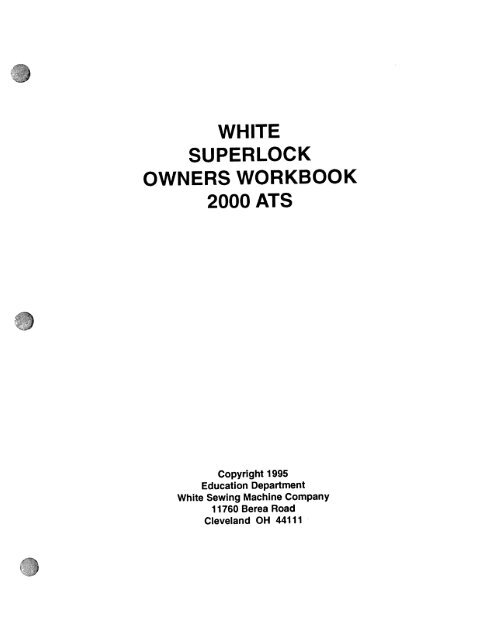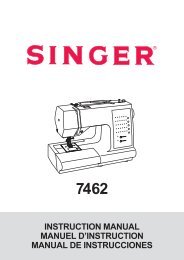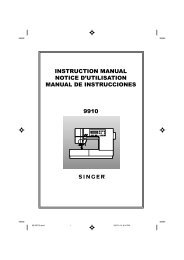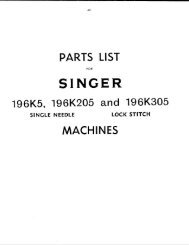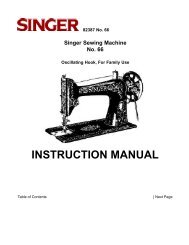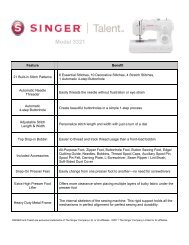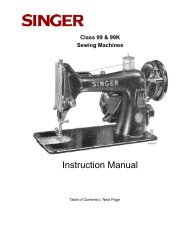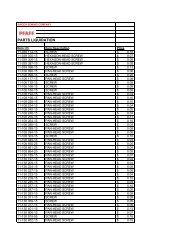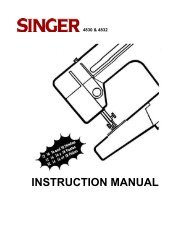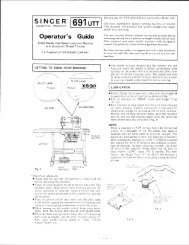WHITE SUPERLOCK OWNERS WORKBOOK 2000 ATS - Singer
WHITE SUPERLOCK OWNERS WORKBOOK 2000 ATS - Singer
WHITE SUPERLOCK OWNERS WORKBOOK 2000 ATS - Singer
You also want an ePaper? Increase the reach of your titles
YUMPU automatically turns print PDFs into web optimized ePapers that Google loves.
<strong>WHITE</strong><br />
<strong>SUPERLOCK</strong><br />
<strong>OWNERS</strong> <strong>WORKBOOK</strong><br />
<strong>2000</strong> <strong>ATS</strong><br />
Copyright 1995<br />
Education Department<br />
White Sewing Machine Company<br />
11760 Berea Road<br />
Cleveland OH 44111
INTRODUCTION<br />
TABLE OF CONTENTS<br />
SECTION I - Know Your Machine - Model <strong>2000</strong> <strong>ATS</strong> 3<br />
Accessories 4<br />
Superlock Set Up and Maintenance 5<br />
Foot Control 5<br />
Power/Light Switch 5<br />
Opening Front Cover 5<br />
Closing Front Cover 5<br />
Opening Swing-Away Side Cover 5<br />
Handwheel 6<br />
Presser Foot Lift 6<br />
Changing Presser Foot 6<br />
Adjustment of the Presser Foot Pressure 6<br />
Disengaging Upper Cutter 7<br />
Exclusive Built-in Thread Cutter 7<br />
Adjustable Fabric Guide 7<br />
Waste Tray 7<br />
Oiling 8<br />
Cleaning 8<br />
Storage 8<br />
Hints for Successful Stitching 9<br />
Needle Replacement 10<br />
Needles, Thread & Fabric Chart 11<br />
SECTION II - Threading & Tension 12<br />
Preparation for Threading 12<br />
Spool Holders 12<br />
Spool Caps 12<br />
Spool Nets 12<br />
Threading Upper Looper 14<br />
Threading Lower Looper 15<br />
Threading Needles i 6<br />
Needle Threader i<br />
Helpful Hints -<br />
Changing<br />
Thread 18<br />
Testing Stitch 19<br />
Thread Tensions 20<br />
Adjusting Thread Tension 21<br />
SECTION Ill - Basic Sewing Techniques 22<br />
Superlock Seams & Seam Finishing 23<br />
Adjusting Stitch Length 24<br />
Adjusting Cutting Width & Balance of Stitch 25<br />
Adjusting Cutting Width 26<br />
Securing Beginning & End of Seam 27<br />
Outside Corners 28<br />
Inside Corners 29<br />
Corded Overlock 30<br />
Ribbing 31<br />
Casing or Hem Fold 32
SECTION IV - Differential Feed 33<br />
Positive Differential Feed 34<br />
Minimal Differential Feed 34<br />
Normal Differential Feed 34<br />
Serging Lightweight Fabrics 35<br />
Serging Stretch or Bulky Knits 36<br />
Gathering 37<br />
SECTION V - 3-Thread Sewing Techniques 38<br />
3-Thread Seam or Edge Finish 39<br />
Rolled Edge 40<br />
Picot Edge 41<br />
Spaghetti Straps 42<br />
Slit or Placket 43<br />
Rolled Edge -1’Pokies” 44<br />
Narrow Edge 45<br />
Safelock 46<br />
Decorative Edges 47<br />
Decorative Braids 48<br />
Flatlock/Ladder Stitching & Seams 49<br />
Flatlock Technique -<br />
- Flatlock Technique<br />
Flatlock Technique -<br />
Rolled Edge -<br />
Rollled Edge -<br />
Novelty<br />
Fishline<br />
Lace<br />
Lingerie<br />
Fringe<br />
Application 50<br />
Elastic Application 51<br />
52<br />
Threads 53<br />
Ruffles or Wire Edges 54<br />
Narrow or Shell Edge 55<br />
SECTION VI - 2-Thread Sewing Techniques 56<br />
Threading for 2-thread Sewing 56<br />
Two Thread Overcast 57<br />
Two Thread Flatlock 58<br />
Two Thread Wrapped Edge 59<br />
Two Thread Rolled Edge 60<br />
SECTION VII - Optional Accessory Feet 61<br />
Blind Hem Foot 61<br />
Piping/Cording Foot 62<br />
Elastic Foot 63<br />
Shirring Foot 64<br />
SECTION VIII - Special Hints 65<br />
Puckery Fabric 65<br />
Skipped Stitches 65<br />
Stitiches Show Through on the Right Side of Seam 65<br />
Thread Continues to Break 65<br />
Cannot Get a Tight Stitch at the Cut Edge of the Fabric 66<br />
Adjusting Tensions 66<br />
Machine is Jamming 66<br />
INDEX 67-69<br />
II
INTRODUCTION<br />
Welcome to the world of easy, speed sewing. The White Superlock was designed with<br />
the home sewer mind. It is simple to thread, simple to change from regular sewing to specialty<br />
sewing, such as flatlock and rolled edge. The automatic thread tension release will help you<br />
in easy removal of your projects and creative sewing. This workbook is compiled in a method<br />
so you will thoroughly understand the machine and its potential. After following these<br />
instructions, you will marvel at how easy your new White Superlock is to operate.<br />
2
I<br />
I,<br />
SECTION I<br />
KNOW YOUR MACHINE - MODEL <strong>2000</strong> <strong>ATS</strong><br />
Top of the line Superlock model <strong>2000</strong> <strong>ATS</strong> is a 2/3/4 thread serger with adjustable<br />
cutting width, built in rolled edge and differential feed. It is capable of two, three or four<br />
thread sewing plus many decorative and specialty applications. A section of this workbook<br />
outlines many different techniques, specialty feet, and simple quick projects for you to try<br />
on your new Superlock.<br />
1.KNOWING YOUR MACHINE<br />
IDENTIFICATION CHART<br />
Ci<br />
/“<br />
. _\<br />
-*:--- -j1<br />
(4 )—.-.-._-_-._--.- )<br />
15)<br />
1. Foot pressure regulator<br />
2. Sewing light<br />
3. Presser foot lift lever<br />
4. Thread cutter (Model <strong>2000</strong> only)<br />
5, Needle plate<br />
6. Presser foot<br />
7. Overedge cutting width dial<br />
8. Swing away side cover<br />
9. Thread guide pole<br />
10. Left needle thread tension dial<br />
11. Right needle thread tension dial<br />
12. Lower looper thread tension dial<br />
13. Upper looper thread tension dial<br />
14. Needle thread guides<br />
><br />
15. Thread cutter lever (Model <strong>2000</strong> only)<br />
ThFi<br />
GAvs:Ecovf<br />
16. Two thread convertor instruction<br />
(Model <strong>2000</strong> only)<br />
17. Threading chart<br />
18. Waste tray (Model <strong>2000</strong> only)<br />
19. Foot control<br />
20. Release lever side cover<br />
21. Foot release lever<br />
22. Thread extension plate<br />
23. Differential feed control dial<br />
24. Stitch length dial<br />
25. Hand wheel<br />
26. Plug connector socket<br />
27. Light and power switch<br />
28. Front cover<br />
29. Moving cutter<br />
30. Upper looper<br />
31. Lower looper<br />
0<br />
3
ACCESSORIES<br />
All parts listed may be obtained from your nearest dealer.<br />
H<br />
©<br />
9. Moving cutter<br />
1. Two-thread convertor<br />
10. Spanner<br />
(Model <strong>2000</strong> only)<br />
11. Thread net<br />
12. Tweezers<br />
13. Thread extension plate<br />
14. Cone holder<br />
15. Cord guide<br />
16. Accessory bag<br />
Needle set<br />
Brush<br />
2,<br />
3.<br />
Screwdriver (small)<br />
Needle threader<br />
Machine cover<br />
4.<br />
5.<br />
6.<br />
Screwdriver (large)<br />
Oiler<br />
7.<br />
8.<br />
*only Model <strong>2000</strong> has storage of accessories at the back of front cover.
<strong>SUPERLOCK</strong> SET UP & MAINTENANCE<br />
1. Set your Superlock on a sturdy, flat surface.<br />
2. Your Superlock has been thoroughly oiled at the<br />
factory so be sure to wipe the needle and bed<br />
plate areas carefully before sewing a garment.<br />
Practice on a scrap of fabric so any surplus oil<br />
is absorbed.<br />
3. FOOT CONTROL<br />
Push foot control plug into the connector socket<br />
at the bottom right side of your Superlock.<br />
4. POWER/LIGHT SWITCH<br />
To operate your machine, turn the power switch<br />
on. It is located at the bottom right hand side.<br />
The same switch controls both power and light.<br />
If leaving your Superlock unattended, turn<br />
switch off.<br />
5. OPENING FRONT COVER<br />
To open front cover, push part B of cutter cover<br />
to right and pull the cover down toward you.<br />
To open the side cover, press down on the<br />
silver knob located to the inside of the side cover,<br />
and swing the lower left portion of the Superlock<br />
to the left.<br />
6. CLOSING FRONT COVER<br />
Push part B and lower left cover toward the<br />
center of the front to close it.<br />
Note: Always close front cover when sewing.<br />
7. OPENING SWING-AWAY SIDE COVER<br />
To open side cover, pull the release lever toward<br />
you with your right hand and swing out to left.<br />
NOTE: Always close side cover when sewing.<br />
Swing away<br />
sde cover<br />
5
8. HAN DWHEEL<br />
Always turn handwheel toward you.<br />
9. PRESSER FOOT LIFT<br />
Raise the presser foot lift to lift up the<br />
presser foot.<br />
10. CHANGING PRESSER FOOT<br />
Switch off your Superlock.<br />
Raise presser foot.<br />
Raise needles to their highest position by<br />
turning handwheel toward you.<br />
Push lever A and foot will come off.<br />
Position the new foot with pin right under<br />
the groove of the ankle. Lower presser foot<br />
lift so that holder catches the presser foot.<br />
11. ADJUSTMENT OF THE PRESSER<br />
FOOT PRESSURE<br />
The presser foot pressure is pre-adjusted<br />
for materials of medium thickness.<br />
Adjustment is necessary only when<br />
you work on very thin or very thick<br />
materials. Accordingly, sew thinner<br />
materials with less pressure (2 - 3)<br />
and thicker materials with more pressure<br />
(4 - 5). Increase the pressure of the presser<br />
foot by turning the dial to the desired number.<br />
Foot release lever<br />
6
12. DISENGAGING UPPER CUTTER<br />
To lower the upper cutter, open the left<br />
front cover and turn the cutter knob toward<br />
you until the cutter is all the way in the<br />
down position. BE SURE TO PUT CUTTER<br />
BACK UP BEFORE SEWING.<br />
13. EXCLUSIVE BUILT-IN THREAD CUTTER<br />
The built-in scissor conveniently cuts your<br />
thread tail simply by pressing down on the<br />
lever as illustrated, then releasing to cut.<br />
14. ADJUSTABLE FABRIC GUIDE<br />
The adjustable seam guide can slide to the<br />
left or right as needed to keep fabric straight<br />
while serging seams.<br />
15. WASTE TRAY<br />
Place the large waste tray on the front of<br />
your Superlock by hooking over the slot on<br />
the right front cover and inserting the peg<br />
on the left into the hole on the side cover,<br />
as illustrated.<br />
7
16. OILING<br />
Lubrication is not required often for<br />
this machine since the important parts are all<br />
made of a special oil impregnated sintered<br />
metal. You will want to occasionally put one<br />
or two drops of oil on moving metal parts will<br />
increase durability.<br />
17. CLEANING<br />
First disconnect machine from power supply<br />
by removing plug from the electric outlet.<br />
Open front cover and side cover (see pg. 3).<br />
Using the brush provided, remove all the dust<br />
and lint that has accumulated. Remember to<br />
also clean between the cutters often.<br />
18. STORAGE<br />
When the machine is not in use, disconnect<br />
it from the power supply by removing plug<br />
from the electric outlet.<br />
Using the vinyl cover provided, cover<br />
your machine when not in use.<br />
8
HINTS FOR SUCCESSFUL STITCHING<br />
An understanding of the following variables will make your Superlock run smoothly and<br />
your work will look professional. Before sewing, always test the compatibility of your fabric,<br />
thread, pressure, stitch length, and tension.<br />
Thread Selection<br />
When selecting the proper thread, choose one that is compatible with the fashion and<br />
the fabric. Polyester threads (or polyester based) are most commonly used for general<br />
sewing purposes. Threads of different fibers (cotton, rayon, silk, etc.) are available for<br />
special sewing.<br />
Quality is a very important consideration when selecting a thread. A thread of poor<br />
quality will result in operating and stitching problems on any type of sewing machine. Syn<br />
thetic threads are made by twisting filaments together. Lower quality synthetic threads are<br />
made by twisting short, leftover filaments of polyester together. The result is a Thairy<br />
appearance and a weaker thread. Better quality threads are made by twisting long continu<br />
ous filaments together. This thread is stronger and smoother, thus fewer operating prob<br />
lems will occur. Brand name and price do not necessarily represent quality in a thread.<br />
The only true test of thread quality is close examination.<br />
Poor Quality Good Quality<br />
A variety of threads are available for overlocks. They may be of cotton, cotton-<br />
wrapped polyester, polyester or nylon (Wooly Nylon®). These are most often put up on<br />
cones or tubes. Threads for the overlock are generally finer and lighter in weight than<br />
standard sewing machine thread. This is because of the large amount of thread that builds<br />
up in an overlock seam. Finer thread makes for a less bulky seam. Your Superlock will<br />
handle thread on cones or spools. Many decorative threads will be discussed later in this<br />
workbook.<br />
9
Replace needles in the following way:<br />
NEEDLE REPLACEMENT<br />
1. Bring needles to their highest position by turning handwheel towards you.<br />
2. Lower presser foot.<br />
3. Open front cover: the screwdriver and needles are located inside the handy storage<br />
area.<br />
4. When replacing right needle, loosen right needle clamp screw, marked “Re, and remove<br />
needle. Be sure to store extra loose needles in needle cushion.<br />
To replace left needle, loosen left needle clamp screw.<br />
5. With the flat side away from you, insert the new needle into groove of needle bar as far<br />
as it will go. Use an Organ brand HA x 1 SP. These are standard needles used for home<br />
sewing.<br />
Change needles after each garment for best results.<br />
away<br />
from<br />
you.<br />
Left needle<br />
clamp screw<br />
Right needle<br />
clamp screw<br />
10
Needles<br />
NEEDLES, THREAD & FABRIC CHART<br />
Proper needles are important when using your White Superlock. A standard sewing<br />
machine needle of good quality, Organ brand HA X 1 SP, can be used on your<br />
Superlock. Change needles often for best results.<br />
Caution: Do not used banded needles (i.e., yellow band) on your White Superlock.<br />
These can cause skipped stitches and possibly bend or break needles or damage<br />
loopers.<br />
Threads<br />
Any good quality cotton, polyester, silk, synthetic threads, etc., can be used on your<br />
Superlock. Wooly Nylon®, a stretchy, yarn-like thread, is recommended in upper<br />
and lower loopers for rolled edge and lingerie sewing.<br />
Fabric Thread Needle<br />
Lightweight:<br />
COTTON Organdy, Lawn, Calico<br />
LINEN<br />
Heavyweight<br />
Oxford, Denim, Corduroy<br />
Cotton #80<br />
Polyester #60 - 50<br />
Cotton #60<br />
Lightweight: Polyester #80<br />
Tropical, Wool, Poplin Cotton #60<br />
WOOL Mediumweight: Polyester #80-60<br />
Gabardine, Flannel Cotton #60<br />
Heavyweight: Polyester #60-50<br />
Velours, Camelhair Cotton #60<br />
90 (14)<br />
for general<br />
sewing<br />
Lightweight: Polyester #100-80 75 (j)<br />
SYNTHETIC Georgette, Crepe, Voile Cotton #120-80<br />
for light-<br />
FIBER Heavyweight: Polyester #60 weight<br />
Taffeta, Twills, Denim Cotton #60 fabrics<br />
Tricot<br />
Polyester #80-60<br />
KNIT Cotton #80-60<br />
Jersey, Interlock<br />
Wool<br />
Polyester #60-50<br />
Cotton_#60<br />
Polyester #60-50<br />
Wooly Nylon<br />
11
Preparation for Threading<br />
Spool Holders<br />
For large cones of thread, use the black plastic<br />
cone holders. This will help hold the cone of<br />
thread in place.<br />
SECTION II- THREADING & TENSION<br />
Spool Caps<br />
When using small spools, remove the<br />
plastic cone-spool holders (a drop of oil will<br />
make the holder slide off easily), and place the<br />
spool directly on the spool pin. Use the spool cap<br />
to keep the spool in place and to prevent the<br />
thread from catching on edges of the spool.<br />
Spool Nets<br />
Spools of specialty thread sometimes work loose<br />
from the spool during sewing, causing tangling or<br />
irregular thread feeding. To prevent this use the<br />
spool net provided as shown.<br />
Extension plate<br />
Spool cap<br />
Domestic cotton reel<br />
s- Cone type thread<br />
Cone holder<br />
_______<br />
Thread comes off the top<br />
NOTE: Specialty threads, such as fine perle cotton, Designer 6 by YLI®, Ribbon Floss®,<br />
and Pearl Crown Rayon® by YLI may be used in the loopers of your Superlock.<br />
For successful stitching be sure these threads feed off their spools or skeins easily.<br />
Spool<br />
r Spool<br />
Turn up<br />
12
Your White Superlock is very easy to thread. With some practice you will be<br />
able to thread it in a few minutes without using any tools. Master the correct<br />
threading before starting your first project.<br />
To become familiar with your Superlock, practice on scrap fabric with different<br />
color threads to identify placement and function of each thread.<br />
Threading must be carried out in the following sequence for total ease of<br />
operation: upper looper - lower Looper - right needle - left needle.<br />
Extend the thread pole to its highest point, then turn it until the shaft clicks<br />
into its locked position. Place threads on spools and draw ends through the<br />
guides from rear to front.<br />
Thread guide<br />
Thread guide pole<br />
Your Instruction Manual shows threading the lower looper first. We have<br />
found that threading your upper looper first is easier and will allow your<br />
threads to lay in the correct order for a proper stitch.<br />
13
Open front covers.<br />
THREADING UPPER LOOPER<br />
Bring the upper looper to its lowest position by turning the handwheel toward you<br />
Draw thread from spool and pass it through the thread stand (back to front), under<br />
thread clip guide (1) and then, in order, through guides 2-4 as illustrated below and<br />
inside the front cover of your Superlock.<br />
With the presser foot raised to release tension, lay thread between<br />
thread tension discs. (2) Be sure thread is all the way into the tension discs.<br />
Snap thread into guide A, B, and C (illustration 3), then thread the hole of the upper<br />
looper (4) using the tweezers provided if necessary.<br />
Bring thread tail under foot and toward back left corner of your Superlock.<br />
14
THREADING LOWER LOOPER<br />
Bring the thread from the spool through thread guide back to front of the thread stand<br />
under (1) and then, in order, through guides 2-4 as illustrated below and inside front<br />
cover of your Superlock.<br />
With the presser foot raised to release tension, lay thread between thread<br />
tension discs. Be sure thread is seeded all the way into the tension discs.<br />
Bring the lower looper to the far left position by turning the handwhee toward you.<br />
Snap thread into thread guides A, B, and C (illustration 3), then hook the thread guide<br />
onto the lower looper thread guide D (Figure 3).<br />
Then move the lower looper slightly to the right by turning the handwheel toward you.<br />
Thread the eye of the lower looper D (Illustration 3). You may wish to use the tweezers<br />
provided.<br />
Bring thread tail under foot and toward the back left corner of the Superlock.<br />
15
Raise the needles to their highest position.<br />
THREADING NEEDLES<br />
Bring the thread from the spool and pass it through the guides on thread stand (back to<br />
front), then under thread clip (1).<br />
Lay thread between thread tension discs (2). Be sure thread is seeded all the way into the<br />
tension discs.<br />
Pass thread through guides A and B for each needle.<br />
Thread each needle(s) eye (4) using your needle threader found in the storage area of the<br />
right front cover.<br />
To thread right needle, lower presser<br />
foot and raise needles to their highest<br />
position. Follow illustrations 1-6 (next<br />
page) inserting left peg of needle threader<br />
into hole on right side of needle bar, then<br />
sliding wire of needle threader through eye<br />
of needle (back to front).<br />
Hook thread under wire hook an dull needle<br />
threader straight back to pull thread through<br />
eye of needle. Place thread tail under presser<br />
foot and toward back left corner.<br />
Thread left needle in same manner, following<br />
illustration Slide right peg of needle threader<br />
into slot on left side of needle bar and continue<br />
same as for right needle. Be sure to put needle<br />
threader back into the built-in accessory<br />
compartment.<br />
16
(For right needle)<br />
0<br />
(For left needle)<br />
NEEDLE THREADER<br />
17
HELPFUL HINTS - CHANGING THREAD<br />
The following steps may be helpful when changing your threads.<br />
.Cut off threads that are on your Superlock<br />
near the spools and replace the<br />
spools with new ones. Tie new thread on<br />
to old threads with overhand or square<br />
knot.<br />
•Raise presser foot and cut the needle<br />
thread(s) right above the needle eye.<br />
•Lower needle bar to its lowest position<br />
by turning the handwheel. With the<br />
presser foot in the highest position, pull<br />
the looper threads until the knots are<br />
about 4K past the presser foot.<br />
•Rethread your needle(s).<br />
18
TESTING STITCH<br />
After threading is completed, test your Superlock stitch in the following order:<br />
1. Be sure both front cover and side cover are closed.<br />
2. Without fabric under the presser foot, lower<br />
presser foot. Pull the ends of the threads<br />
gently with your left hand toward the rear<br />
of the machine, turning the handwheel toward<br />
you a few times to make sure the stitch forms<br />
on the stitch finger (figure 1).<br />
3. Sew on scrap fabric. When you reach the end<br />
of the fabric, raise the presser foot and remove<br />
fabric from your Superlock. Use the handy<br />
thread cutter (figure 3) on your Superlock to cut<br />
your threads. Use the illustrations on the<br />
following pages to check the stitch formation L<br />
produced to see if it is uniform. If not, you will<br />
need to adjust tensions and/or recheck threading.<br />
Fig. 2<br />
Fig. 1<br />
19
THREAD TENSIONS<br />
Thread tensions will vary according to the type and thickness of your thread and fabric.<br />
In most cases these tensions will only vary slightly. Turning the tension dial to a lower<br />
number gives you less tension. Threading your Superlock with four different colors of<br />
thread will help you identify the placement and function of each thread.<br />
Upper Looper Thread should be flat on the top side of fabric and lock with the<br />
lower looper thread on the edge.<br />
Lower Looper Thread should be flat on the underside of fabric and lock with the<br />
upper looper thread on the edge.<br />
The needle threads should lay mainly on the top side like rows of normal straight<br />
sewing. The left needle will form a line of sewing along the left edge connecting the<br />
two looper threads and the right needle acts as a safety stitchN forming a line of<br />
stitching through the upper looper thread.<br />
Set your Superlock according to the tensions recommended below. Try test sewing on<br />
a piece of medium weight fabric. If you need to change the tensions mark them down<br />
for future reference.<br />
Left Needle (LN) _4_<br />
Right Needle (RN) _4_<br />
Upper Looper(UL) _4_<br />
Lower Looper (LL) _4_<br />
We will refer to these tensions as normal.<br />
These tension recommendations are for average strength thread tension. It may be<br />
necessary to adjust the thread tension(s) slightly as different weights of fabric and<br />
thread can make a difference. Your tensions should remain in the outlined area on the<br />
tension dial.<br />
20
Left Needle Thread Loose<br />
and visible on underside of<br />
fabric.<br />
Just Right<br />
Unner sde<br />
Increase left needle tension<br />
and/or decrease both loopers.<br />
ADJUSTING THREAD TENSION<br />
Upper Looper Thread<br />
Pulled to the Underside<br />
Increase upper looper thread Increase lower looper thread<br />
tension and/or decrease lower tension and/or decrease upper<br />
looper tension, looper tension.<br />
Right Needle Thread Loose<br />
and visible on underside of fabric.<br />
Increase right needle thread tension.<br />
Lower Looper Thread<br />
Pulled to the Top Side<br />
Under s de<br />
21
SECTION III<br />
BASIC SEWING TECHNIQUES<br />
Sew samples for the next section of this workbook, and record your<br />
tension settings on each page for future reference.<br />
22
<strong>SUPERLOCK</strong> SEAMS & SEAM FINISH<br />
Seam and overcast all in one step. Your Superlock produces fast, professionally-<br />
finished garments.<br />
Machine Setting<br />
Stitch Length: 2-3<br />
Stitch width: 6<br />
Fabric<br />
Medium weight woven<br />
Tension Setting<br />
Set your tension to normal setting and note.<br />
Left needle (LN) - 4 -<br />
Right needle (RN)-4-<br />
Upper looper (UL)-4-<br />
Lower looper (LL)-4-<br />
To Seam & Overcast<br />
•Fold fabric in half.<br />
__________ __________<br />
•Place under presser foot with folded edge to be trimmed to the right.<br />
•Use your 518N seam allowance as a guide.<br />
•Serge seam.<br />
•Lift the presser foot, and pull your sample away. And cut the threads<br />
using the thread cutter.<br />
To overcast raw edges for conventional seaming - Serge one edge of above<br />
sample to finish raw edge. Mount your sample on the facing page.<br />
23
)<br />
ADJUSTING STITCH LENGTH<br />
Turn the stitch length dial (located on the right side of your Superlock) until the<br />
required length is at the guideline. The higher the number, the longer the stitch.<br />
With the dial you can adjust the stitch length from R for rolled edge to 5mm.<br />
Stitch Length Sample<br />
Machine Settings<br />
Stitch length: 1 - 5 (see illustration)<br />
Stitch width: 6<br />
Fabric Medium weight woven<br />
Tension Settings<br />
Normal LN -4-<br />
RN -4-<br />
UL -4-<br />
LL -4-<br />
Stitch length dial<br />
T]o<br />
Serge<br />
•Fold fabric in half.<br />
•Set stitch length to 5mm.<br />
•Stitch along edge stopping every inch and<br />
decreasing stitch length to 4, then 3, etc.<br />
/<br />
24
ADJUSTING CUTTING WIDTH &<br />
BALANCE OF STITCH<br />
The cutting width can be adjusted from 4mm to 7mm by simply turning the cutting<br />
width dial according to the type of fabric you are working with. This fine tune adjustment<br />
allows you to achieve the best stitch possible on all fabric types.<br />
The normal setting for the cutting width is 6mm.<br />
Adjust the cutting width by turning the dial on the left side of the Superlock. If the cutting<br />
width is narrower than the stitch width, leaving loops off the edge of the fabric, turn the<br />
cutting width adjustment dial toward 7.<br />
width dial<br />
If the cutting width is wider than the stitch width causing a pucker within the overlock<br />
J seam, turn the cutting width adjustment dial toward 4.<br />
25
ADJUSTING CUTTING WIDTH<br />
The cutting width can be changed for different techniques and types of fabric.<br />
Loosely woven or heavy knit fabrics require a wider width and lighter weight<br />
fabrics require a narrower seam width.<br />
Machine Settings<br />
Fabric<br />
Stitch length: 2.5 - 3.0<br />
Stitch width: 6<br />
Medium weight woven<br />
Tension Settings<br />
Serge<br />
Normal<br />
Serge along one edge with the stitch width on 4mm. Serge along the<br />
other edge with the stitch width at 7mm.<br />
For a narrow or wide stitch width, see three thread sewing techniques on pages<br />
38 and 39.<br />
26
SECURING BEGINNING & END OF SEAM<br />
As most ends of seams and finished edges are later stitched over during garment<br />
construction, it is often not necessary to lock ends. When needed, use one of the<br />
following methods.<br />
Machine Settings<br />
Stitch Length 2.5 - 3<br />
Stitch width 6<br />
Fabric<br />
Medium weight woven<br />
Tension Settings<br />
Normal<br />
(LN) -4-<br />
(RN) -4-<br />
(UL) -4-<br />
(LL) -4-<br />
Securing Beginning of Seam<br />
•Fold fabric in half<br />
‘Stitch 2-3 stitches into fabric, then stop sewing.<br />
•Raise presser foot. Bring chain around left side<br />
of foot and under front of cutter.<br />
‘Lower presser foot and sew, cutting off excess chain.<br />
Securing End of Seam<br />
•Sew to end of fabric.<br />
‘Raise presser foot to release thread tensions and pull fabric V from foot.<br />
‘Reinsert fabric under foot about 1 from end and serge over<br />
previous stitching.<br />
•Raise presser foot and pull sample out.<br />
Use thread cutter to cut threads.<br />
Optional Securing Methods<br />
‘You may tie a knot in the thread ends. This method requires about three<br />
inches of extra thread. After tying knot, trim ends.<br />
‘Use a small amount of Fray CheckTM at the ends.<br />
‘Thread ends into the finished seam. This requires one or two<br />
inches of thread at the end and is usually the best choice for decorative finishes.<br />
27
OUTSIDE CORNERS<br />
You can stitch neat outside corners with litfie practice on your Superlock.<br />
Machine Settings<br />
Stitch Length: 2.5 -<br />
Stitch Width: 6<br />
Fabric<br />
3.0<br />
Medium weight woven<br />
Tension Settings<br />
Normal<br />
(LN) -4-<br />
(RN) -4-<br />
(UL) -4-<br />
(LL) -4-<br />
Serge (Sew along edge of fabric; do not trim.)<br />
•Sew along one side of fabric to the end.<br />
•Raise the needles and presser foot.<br />
•Gently slide the threads off the stitch<br />
finger of the needle plate by pulling fabric toward back of Superlock.<br />
•Grasp the fabric gently and turn the corner.<br />
•Realign the edge of the fabric and put the cut edge of the fabric against the cutter.<br />
•PulI up slack in threads.<br />
•Lower presser foot.<br />
•Serge the edge. Repeat for the remaining corners.<br />
28
INSIDE CORNERS<br />
Practice the inside corner technique for perfect inside corners or curves such as for<br />
Christmas stockings, oven mitts or kick pleats on skirts.<br />
Machine Settings<br />
Stitch Length: 2.5 - 3<br />
Stitch Width: 6<br />
Fabric<br />
Medium weight woven<br />
(Cut a square out of one corner.)<br />
Tension Settings<br />
Normal<br />
(LN) -4-<br />
(RN) -4-<br />
(UL) -4-<br />
(LL) -4-<br />
Serge<br />
•Align the edge with the inside edge of cutter, with bulk of fabric to the left.<br />
•Serge up to 1/2 from the inside corner.<br />
•Careful! Your cutter is 1I2 in front of the needle so you must fold<br />
fabric away from the cutter before the corner reaches it.<br />
•Pull fabric into a straight line and align the unfolded edge against the<br />
inside edge of the cutter. There will be some tucks in the edge.<br />
These should lay flat after stitching.<br />
•Continue to serge along the edge.<br />
Sleeve Placket<br />
•Cut a 2 112N slit in a second piece of fabric.<br />
•Cut a strip of fabric 1 x 5H<br />
•Fold strip in half lengthwise, wrong sides together.<br />
•Lay strip on slit right sides together.<br />
•Using inside corner technique, stitch strip to opening forming a placket.<br />
29
CORDED OVERLOCK<br />
The Specialty Technique Guide consists<br />
of the snap on cord guide (1> found in your<br />
accessory pouch, the guide above the<br />
needles (2) and either hole in the presser<br />
foot (3).<br />
The Specialty Technique Guide guides cord<br />
through the foot and then is covered by the upper<br />
looper thread or is caught by the right needle,<br />
depending on the size of cord you choose. Ribbon<br />
or Cording can be used to stabilize where stress<br />
occurs: joining shoulder seams, sleeves, side<br />
seams, etc. You can also use it for a decorative<br />
look in the areas that are visible. Use filler cord,<br />
perle cotton, twill tape, gimp, wool yarn, elastic<br />
thread, polyester ribbon, etc.<br />
Machine Setting<br />
Stitch Length: 2.5 - 3<br />
Stitch width: 6<br />
Fabric<br />
Sweatshirt Fleece & 1/8” - 3/16” Ribbon<br />
Tension Settings<br />
Normal<br />
IL<br />
(LN) -4-<br />
(RN) -4-<br />
(UL) -4-<br />
(LL) -4-<br />
•Feed ribbon through guides and front hole on foot. Slide ribbon under foot to needles.<br />
‘Fold fabric in half.<br />
‘Serge with four thread seam to stabilize seam.<br />
•Use the back hole in foot for cording, fishline, etc.<br />
30
RIBBING<br />
Your Superlock will finish, trim and allow the material to stretch while retaining its original<br />
shape.<br />
Machine Setting<br />
Stitch Length: 2.5 -<br />
Stitch Width: 6<br />
3<br />
Fabric<br />
Sweatshirt fleece and ribbing<br />
Tension Settings<br />
Normal<br />
(LN) -4-<br />
(RN) -4-<br />
(UL) -4-<br />
(LL) -4-<br />
Serge<br />
•Cut a curved neckline in fabric.<br />
-Fold ribbing in half lengthwise.<br />
•Place ribbing on neckline with raw edges even.<br />
-Serge, stretching ribbing to meet neck edge.<br />
-When attaching ribbing in a circle such as around the neck, serge around<br />
until your stitches overlap one inch. Raise the presser foot and pull your work out, and<br />
cut threads using the thread cutter.<br />
31
CASING OR HEM FOLD<br />
Try this easy technique for T-shirt hems, elastic and drawstring waistbands or curtain<br />
rod casings.<br />
Machine Setting<br />
Stitch Length: 2.5 - 3<br />
Stitch Width: 6<br />
Fabric<br />
Medium weight woven<br />
Tension Settings<br />
Normal<br />
(LN)-4-<br />
(RN)-4-<br />
(UL)-4-<br />
(LL) - 4 -<br />
Serge<br />
•Measure and fold the desired depth for the casing.<br />
•Hold the folded fabric with wrong side facing you.<br />
•Turn the casing underneath so that the fabric now has an NN<br />
shape.<br />
•Serge along the fold with the wrong side up catching both needles into told of fabric.<br />
32


